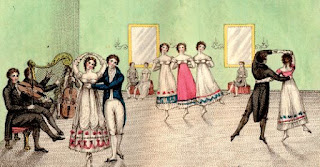This is such a diverse subject, it warranted its own blog post.
Shall we start with the famous Almack’s? I think so. A delightful place where the Ton could gather, admittance by voucher only, of a Wednesday evening. They were served dry, curly sandwiches (a bit like the old British Rail ones), and were under the watchful eye of the patronesses.
Now, in this article it suggests the waltz and quadrille were introduced there in 1815. However, there are other sources which suggest the waltz was danced earlier, and I call artistic license on that one. However, we can all agree that it was only performed with permission from the ladies in charge, once they’d assessed the couples for good conduct – it was a very risqué dance, the waltz! It was in London from 1812 so I used it.
There was a strict dress code enforced. Even the Duke of Wellington infamously got turned away one evening for wearing pantaloons and not the required breeches.
Let us move away from Almack's though. Generally, there was a strict dance etiquette. Please note there’s a difference between dance and set. A couple to dance two sets together was basically announcing an engagement or intent thereof.
In private ballrooms, the floor was often decorated with chalk. This was both pretty and practical. It acted as an anti-slip mechanism for exuberant dancers.
All this frivolity, of course, needed music. There’s a rather decent blog post on musicians and songs here.
Young people were expected to perform at assemblies too. I was shocked when I discovered the lyrics to some of them. For a society so averse to swearing and leud behaviour, their songs didn’t hold back! It seems that one could get away with almost anything if it was sung in a Scottish accent – no, I don’t understand that either. Don’t try to work out the reasoning, it’ll only hurt!
Jane Austen copied out a lot of music. She couldn’t afford to buy new sheet music. I’m not being mean; she simply wasn’t wealthy. There’s a fabulous archive and even a CD of Jane Austen’s Songbook
Apparently, Miss Austen’s preferences extended to Ignaz Pleyel. I’d never heard of him, but found a delightful example on YouTube.
See how nice I am? It took me HOURS to scour the internet for all that. I even contacted Chawton House (who gave me the link to the archive). And here I am, plonking it all in one handy little post for you. <3 nbsp="" span="">
Do you want to dicsuss music eras? It’s worth bearing in mind that any music upon its first release is considered pop music.
Baroque Era – 1600 – 1750
1678 – 1741 = Vivaldi
1685 – 1759 = Handel
Classical Era - 1750 – 1800
1722 – 1809 = Haydn
1756 – 1791 = Mozart
1770 – 1827 = Beethoven
1797 – 1828 = Schubert
Romantic Era – 1800 - 1900
1840 – 1893 = Tchaikovsky
Who hasn’t heard of the pianoforte? Have you even read any Regency romance??
Most poor people would probably only really have opportunity to listen to this instrument at local gatherings. Other instruments and performances were expensive. Professional music was a blessing, a real treat to listen to. It would inspire awe.
And fair enough, the pianoforte was the most popular instrument for young ladies to play, with the harp being favoured by the nobility.
OK, some instruments at the time were:
- Yes, the pianoforte
- Flute
- Guitar (yes, the guitar!)
- Harp
- Harp-lute
- Harpsichord
- Lute
- Lyre
- Organ
- Violin
And a note on music rooms – please note not all people (read hardly any) lived in brand new houses. So, most Regency ladies would have used their drawing room for music performances.
Alrighty, that’s a lot of info. I’ll let all that sink in. Then we can move onto food in the next post. Yum? Hm, maybe, maybe not.
Always in love and light,
TL




No comments:
Post a Comment